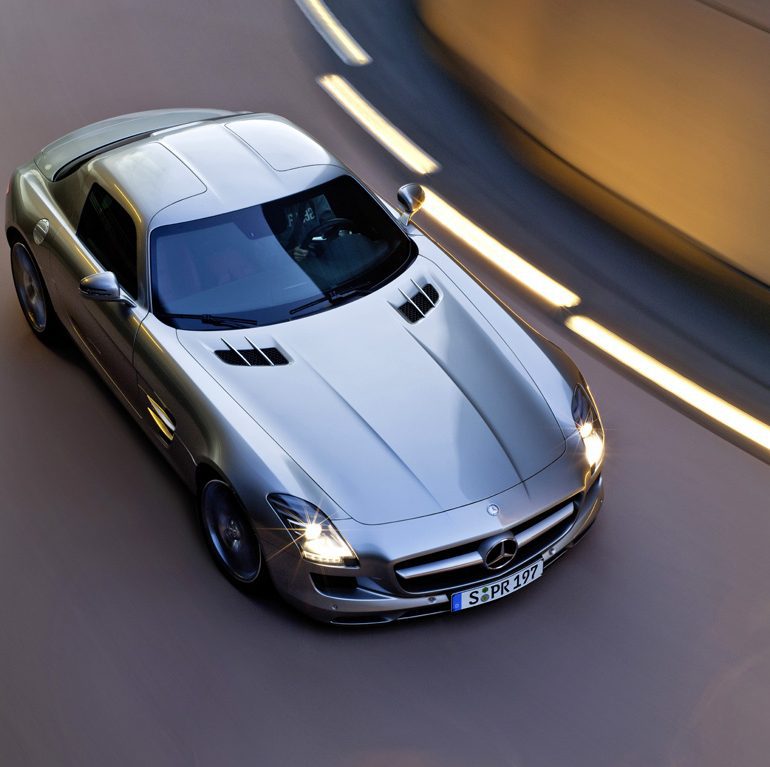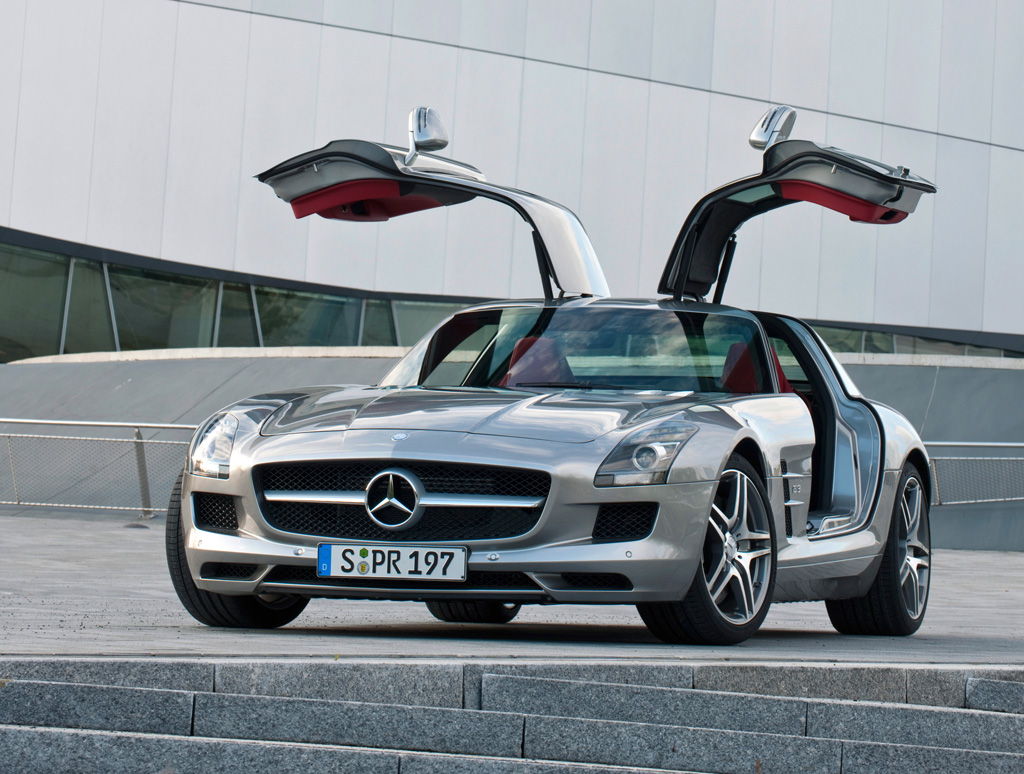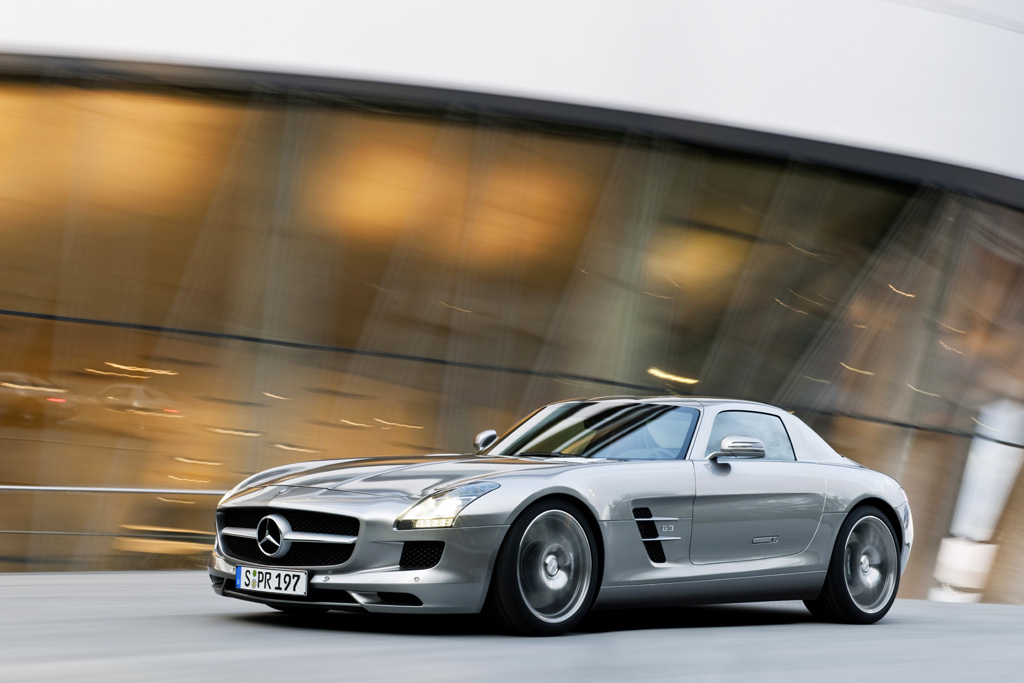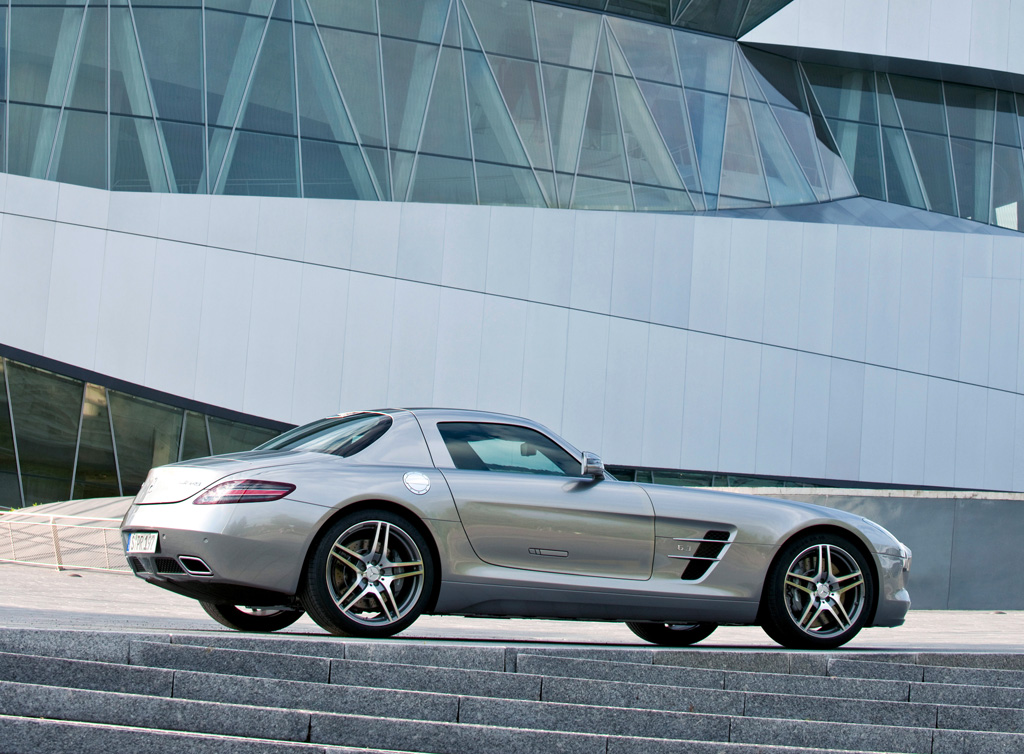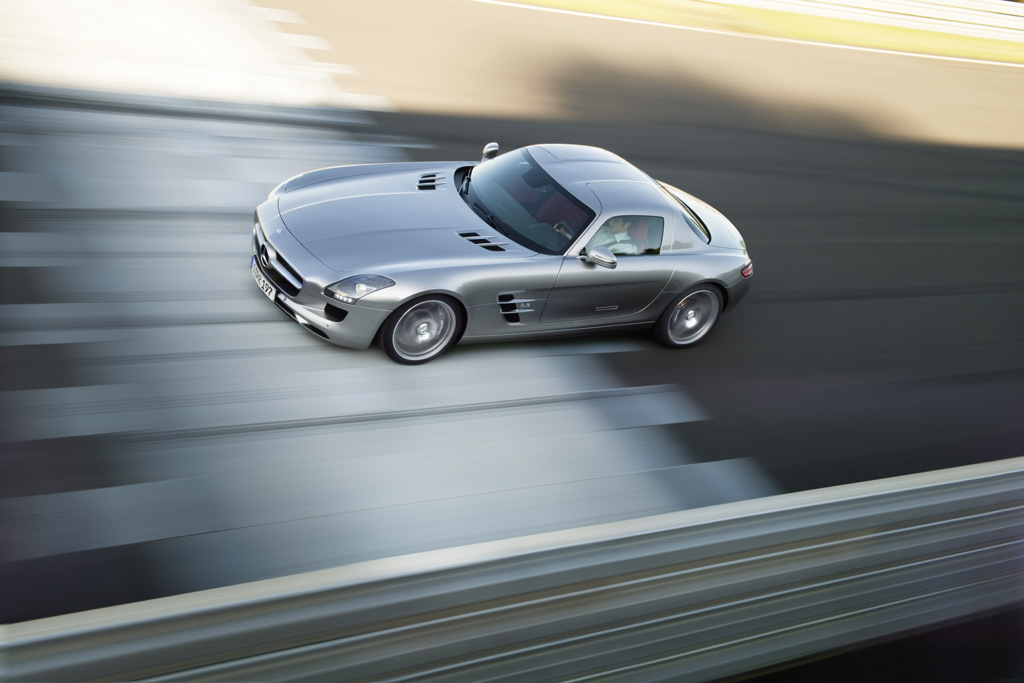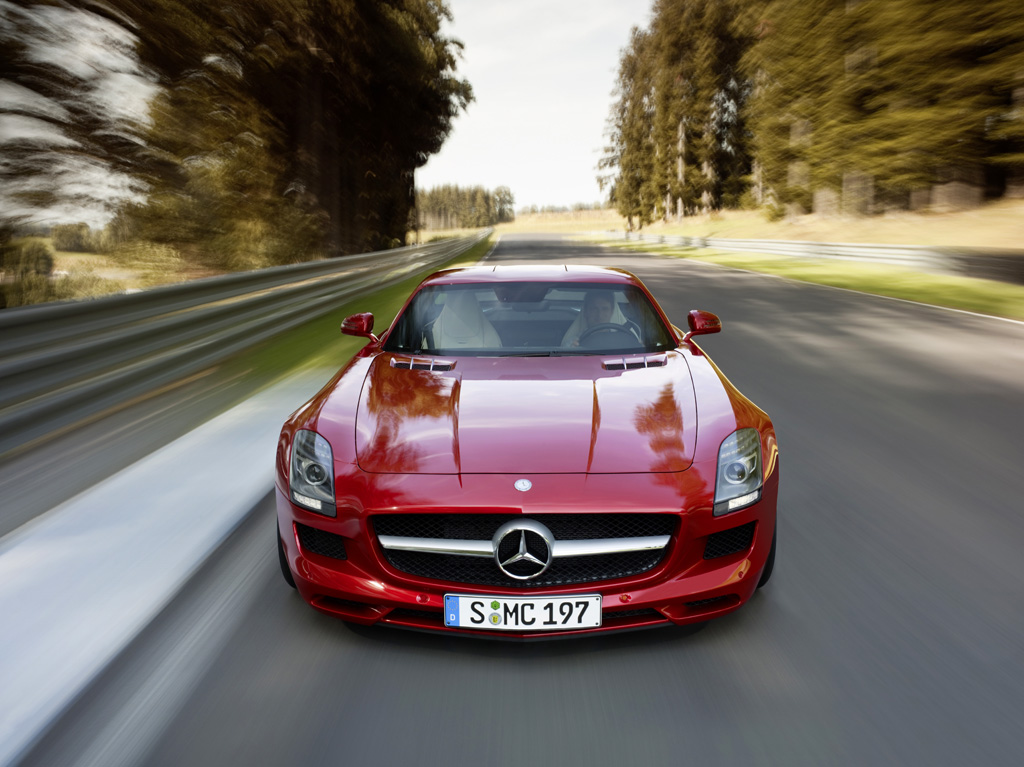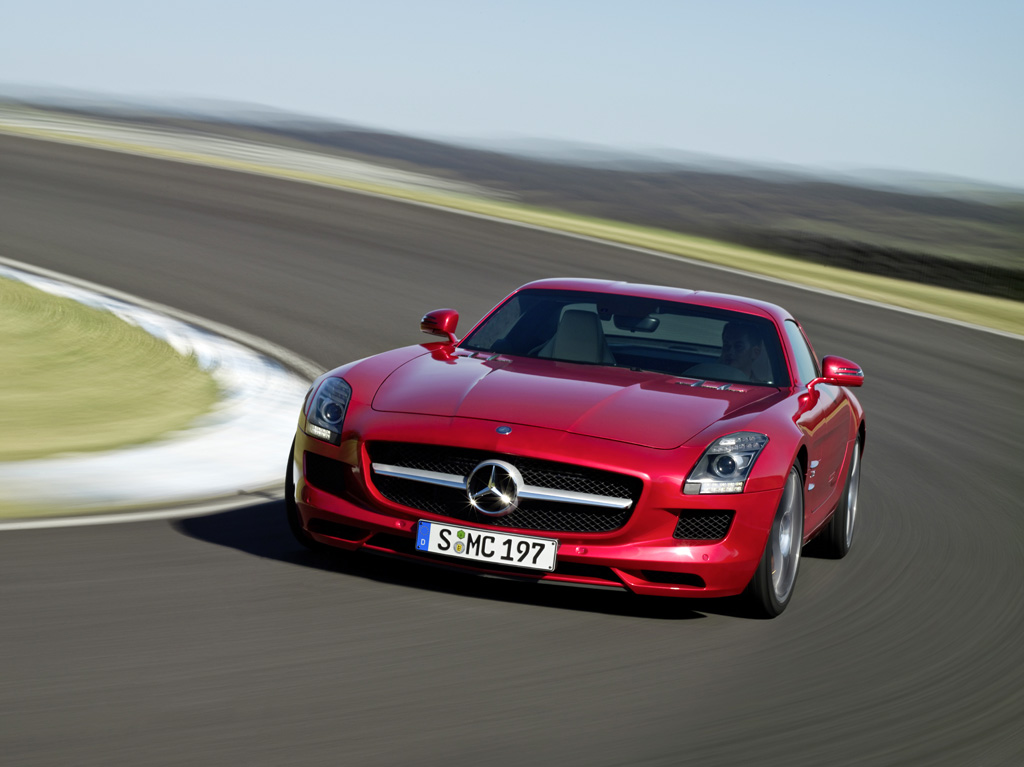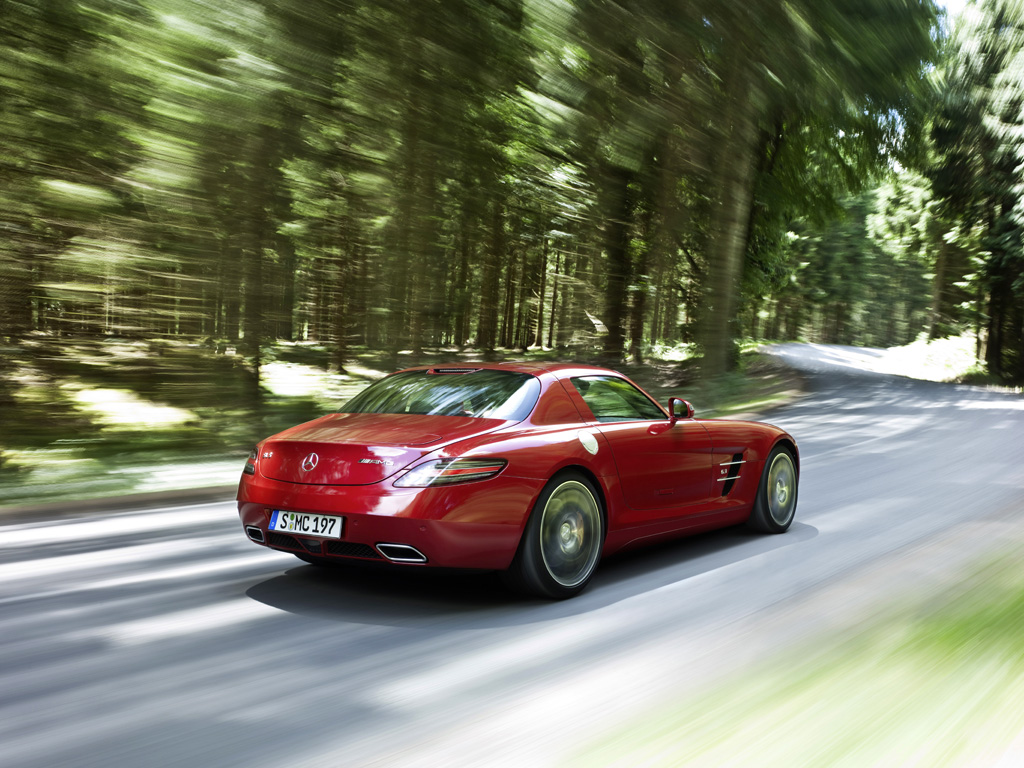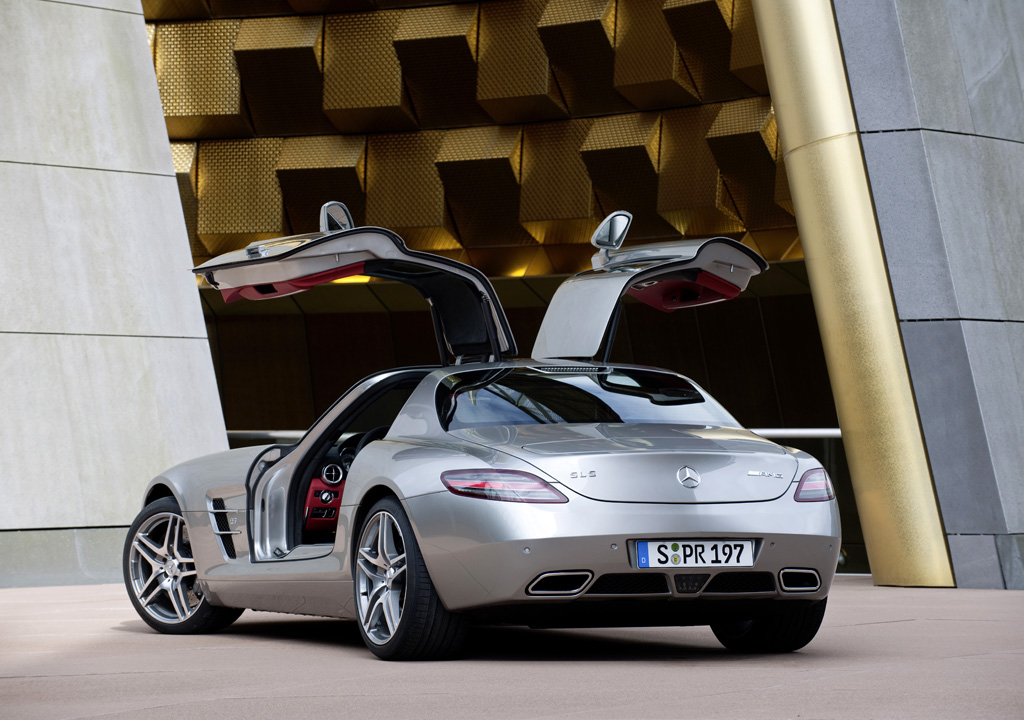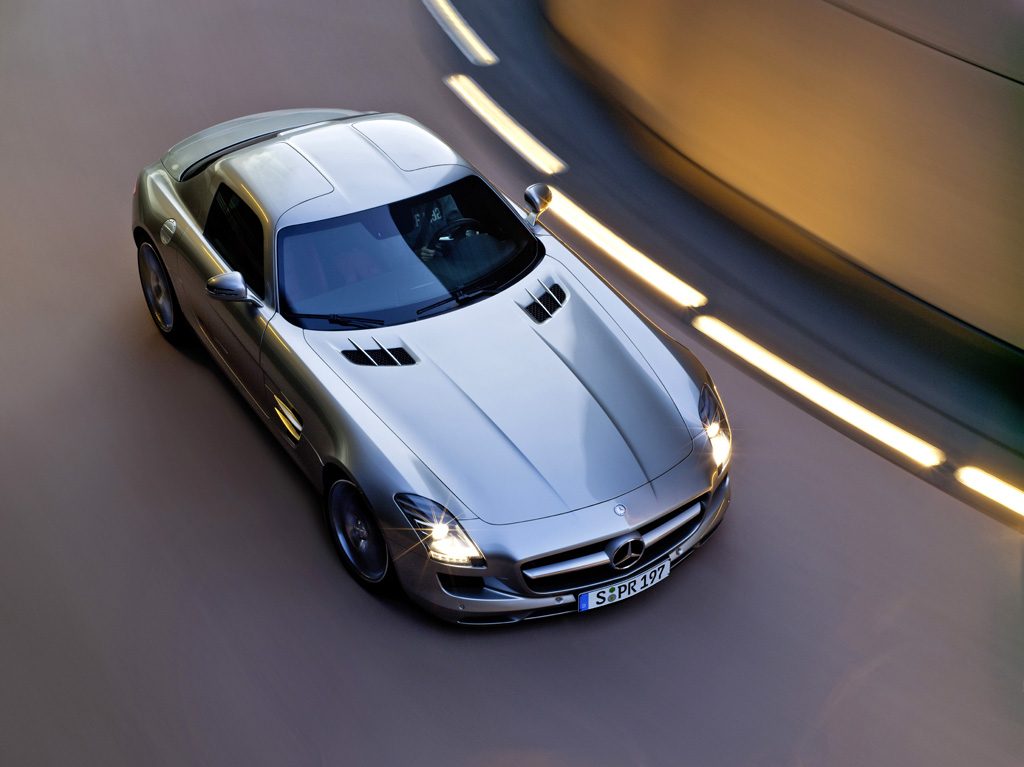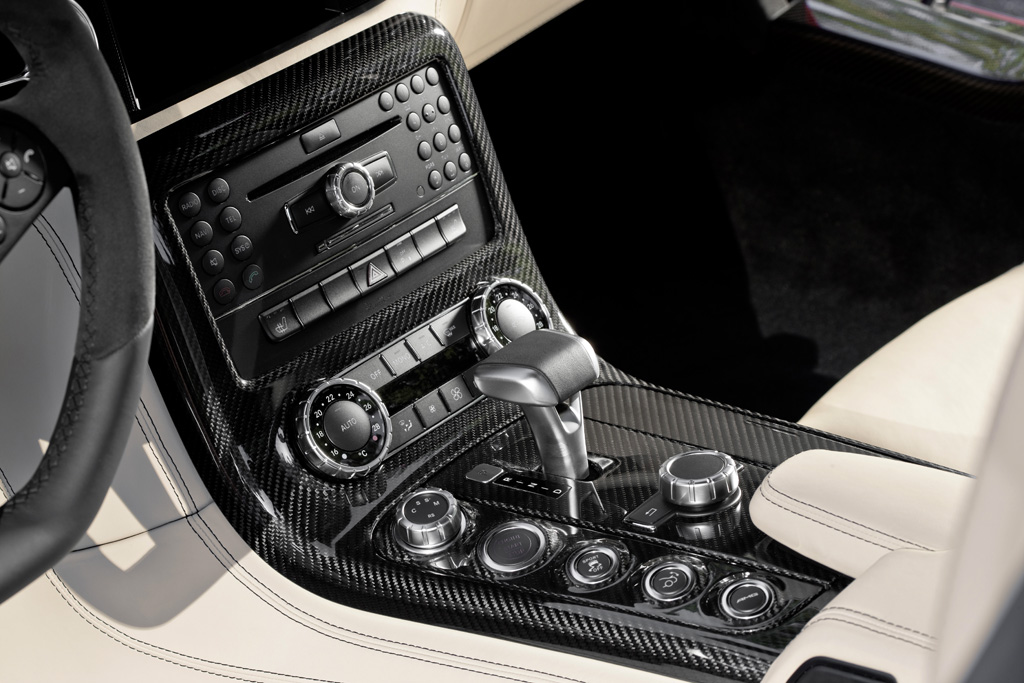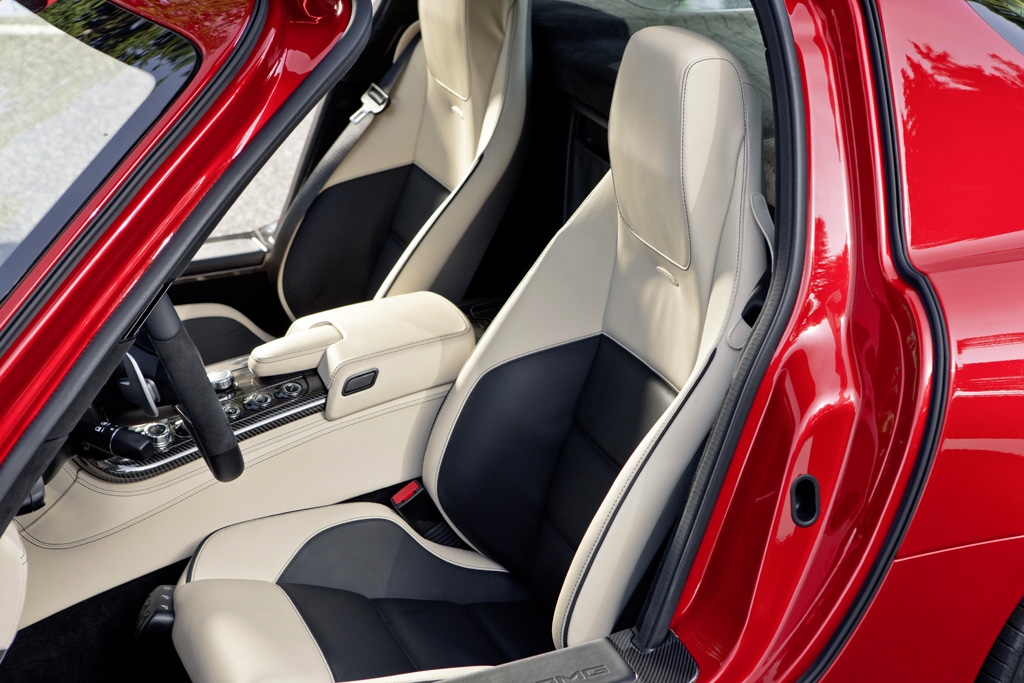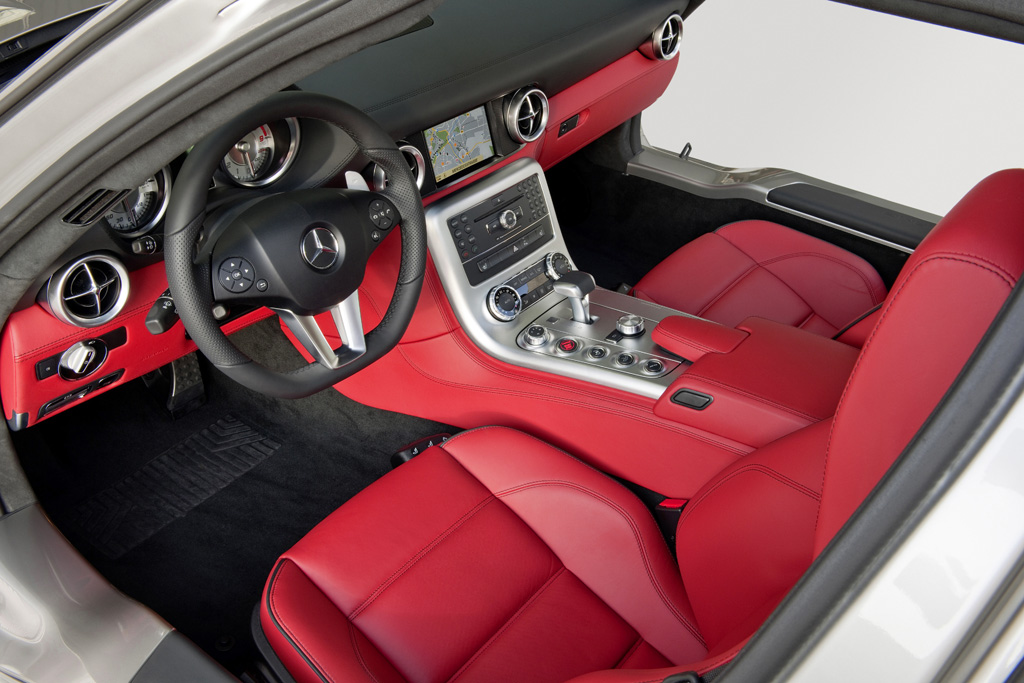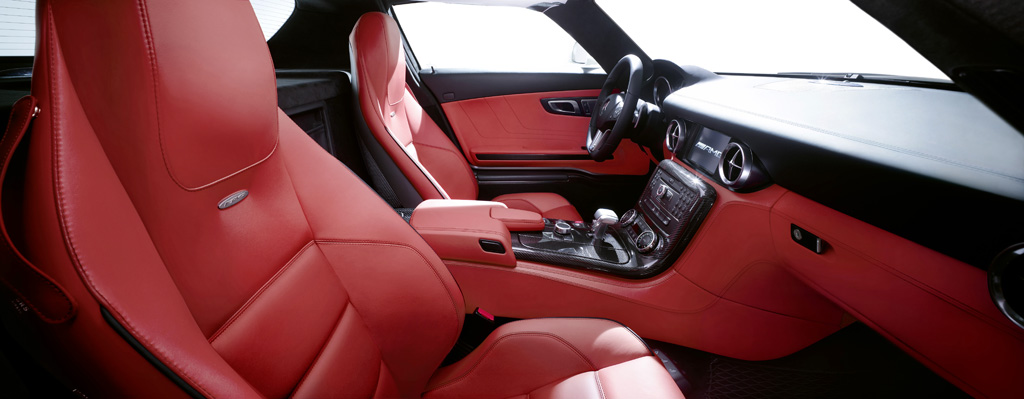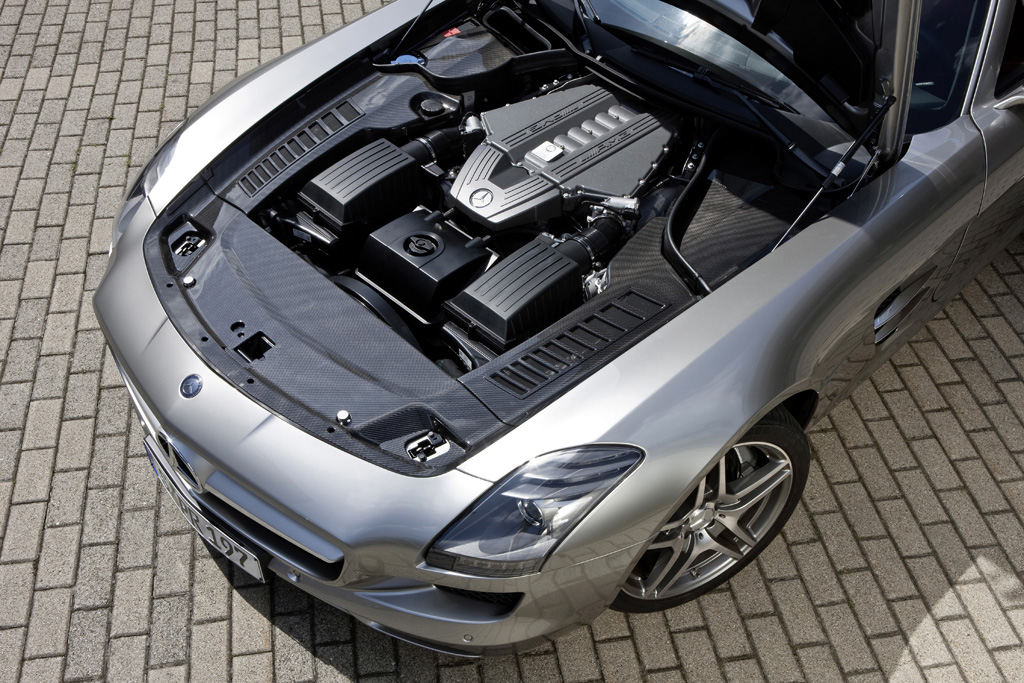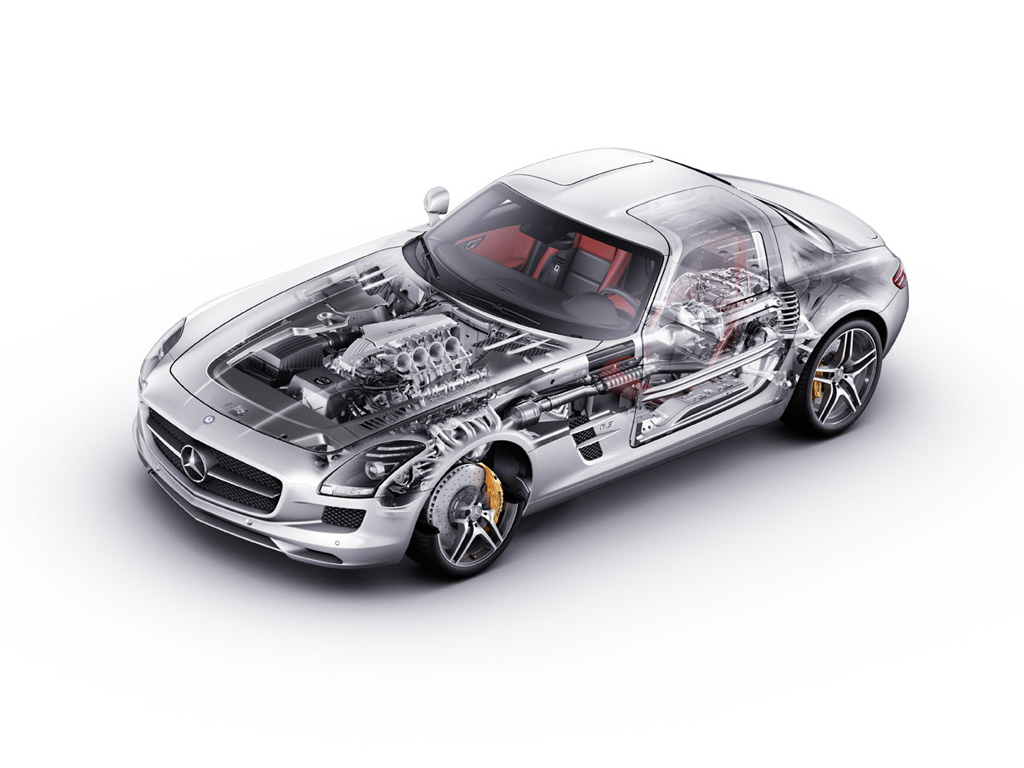2010 Mercedes-Benz SLS AMG
Built as the Mercedes-Benz flagship, the SLS marks the return of Gullwing doors to the lineup and also provides an answer to the Mercedes-Benz SLR McLaren which ceased production.
Architecture for the SLS was originally slated for the fourth generation Viper, but the Daimler/Chrysler split in 2004 left Mercedes-Benz with the project. We suspect only very preliminary details were worked out at that point since AMG takes credit for the entire SLS design. Moreso, it’s the first car designed exclusively by AMG.
The takes makes use of the M159 V8 engine that was specifically designed for motor sports applications. Despite having a displacement of 6208 cc, the engine is marketed as a 6.3 in honor of the Mercedes-Benz M100.
Press Release.
Stuttgart/Affalterbach – The new Mercedes-Benz SLS AMG, which is about to celebrate its world premiere on 15 September 2009 at the International Motor Show (IAA) in Frankfurt/Main, embodies a blend of consummate automotive fascination and high tech. The super sports car delivers a compelling mix of purist styling, consistent lightweight design and superior driving dynamics. At the same time, the SLS fully lives up to all the expectations of hallmark Mercedes everyday practicality and optimum safety. In essence, the new ‘Gullwing’ offers the ideal synthesis of the strengths of Mercedes-Benz and AMG. The reinterpretation of the legendary ‘Gullwing’ is scheduled to be launched in spring 2010. The sales price is EUR 177,310 (incl. 19% VAT).
The new super sports car from Mercedes-Benz and AMG makes for an alluring proposition with its unrivalled technology package: aluminium spaceframe body with gullwing doors, AMG 6.3-litre V8 front-mid engine developing 420 kW/ 571 hp peak output, 650 Nm of torque and dry sump lubrication, seven-speed dual-clutch transmission in a transaxle configuration, sports suspension with aluminium double wishbones and a kerb weight of 1620 kilograms based on the DINstandard – this superlative combination guarantees driving dynamics of the highest order. The ideal front/rear weight distribution of 47 to 53 percent and the vehicle’s low centre of gravity are testimony to the uncompromising sports car concept. The ‘Gullwing’ accelerates from 0 to 100 km/h in 3.8 seconds, before going on to a top speed of 317 km/h (electronically limited). The fuel consumption of 13.2 litres per 100 kilometres (combined) puts it at the front of the competitive field (all figures provisional).
Design
The distinctive styling of the new Mercedes-Benz SLS AMG enthrals with its passionate sportiness and reinterprets the breathtaking lines of the Mercedes-Benz 300 SL – one of the outstanding design icons of the Mercedes-Benz brand. With its purist design the new SLS AMG reflects the philosophy of contemporary sports car engineering: the bonnet which measures just under two metres, the low greenhouse positioned well to the rear and the short rear-end with an extendable aerofoil are just as powerful a reminder of the superlative dynamism as the long wheelbase, the wide track and the large wheels. The short overhangs feed through into the proportions, just as does the design of the super sports car with its low-slung front-mid engine set well back and dual-clutch transmission in transaxle configuration. An undoubted styling highlight comes courtesy of the gullwing doors which lend the SLS AMG its incomparable charisma – making a unique statement in this vehicle segment.
The gullwing doors are not alone in rekindling memories of the Mercedes-Benz 300 SL; the hallmark wide radiator grille with the large Mercedes star and the wing-shaped cross fins are a throwback to the front-end of the sports car legend. The three-dimensional, sculptured front-end with its low-set, swept-back front apron set well into the sides lends the ‘Gullwing’ its powerful stance on the road. Six large cooling air intakes and the vertically arranged headlamps set well to the outside with their alluring inner ambience provide a dominant aura: the central bi-xenon low-beam headlamp with its metallic wing section is framed at the top by two LED indicators and the LED daytime driving lights at the bottom.
Interior
You only need to open the gullwing doors on the Mercedes-Benz SLS AMG and ease into the sports seats to experience a whole new level of interior. The Mercedes-Benz designers took their inspiration from aircraft construction when styling the interior – immediately bringing an aircraft cockpit to mind. The characteristic styling feature is the dashboard, whose powerful and dramatic wing shape makes for an impression of width. Strikingly integrated into the dashboard are the galvanised air vents with their adjustable, cruciform nozzles and Silver Shadow finish – their shape reminiscent of a jet’s engines. The instrument cluster with its LED upshift indicator and two white backlit dial instruments add another decidedly sporty touch with their metallic Silver Shadow finish. The silver dials have red needles and a 360 km/h speedometer scale. As a central feature of the cockpit, the COMAND APSmultimedia system with its 7-inch screen is integrated between the two centre air vents.
The elongated centre console in matt metal similarly picks up on the design theme of the aircraft cockpit. It is home to the AMGDRIVE UNIT, which is inclined towards the SLSdriver and allows them to choose their very own vehicle setup. The E-SELECT shift lever, whose styling recalls the thrust control of a jet, controls the AMG SPEEDSHIFT DCT 7-speed sports transmission. All the controls are made out of solid metal, with a high-sheen Silver Shadow surface.
The concave inner panels of the gullwing doors, the high beltline and the powerful side sill panels round off the cockpit-like impression, while imparting a feeling of sports car-like ergonomics. Fine materials such as nappa leather, solid metal and (optional) genuine carbon-fibre facings underline the pronounced “custom-built” nature of the SLS interior, and show enormous attention to detail. Five different designo leather colours are available to meet individual preferences: black, classic red, sand, porcelain and light brown.
Gullwing doors
Despite the low sitting position of just 369 millimetres in typical sports car fashion, the wide-opening gullwing doors make it easy to get in and out of the vehicle. At the design stage great attention was paid to the widest possible opening angle – it is a full 70 degrees. Equally importantly, the distance between the open doors and the road surface is a generous 1.50 metres, while the entry aperture between the open doors and the upper edge of the door sills measures no less than 1.08 metres. The entrance height, i.e. the distance between the road surface and the upper edge of the door sills is a very low 45 centimetres. As another important criterion for dignified access and egress, two gas-pressure struts positioned next to the door hinges require only very little pressure when opening and closing the doors – even at very low ambient temperatures.
The gullwing doors require less opening space than conventional coupé doors, and can be fully opened in a normal garage. The door is opened from inside by a handle finished in Silver Shadow. The grip section of the armrest moulded into the interior door panel ensures problem-free door closing. The operating buttons for the power windows, central locking system and exterior mirror adjustment are also located in the interior door panels for easy access. The feeling of comfortable spaciousness is in large measure due to the generous shoulder-room of 1483 millimetres and elbow room of no less than 1606 millimetres. In conjunction with the generous maximum headroom of 990 millimetres and effective legroom for the driver of 1058 millimetres, the result is a low but extremely relaxed seating position. At the same time the intentionally steep angle of the windscreen ensures good all-round visibility for the passengers.
Aluminium spaceframe
The SLS is also breaking the mould when it comes to the body concept: for the first time, Mercedes-Benz and AMG are presenting a car with an aluminium chassis and body. Compared with the traditional steel design, this results in a significant weight saving, clearly illustrated in the DIN kerb weight of 1620 kilograms.
The newly developed bodyshell comprises an aluminium spaceframe. This exclusive design combines intelligent lightweight design with outstanding strength – thus delivering superlative driving dynamics. Lightweight aluminium sections connect the force nodes to a sturdy structure. The large, low-set cross-sections of these aluminium sections ensure high resistance torque, thus providing the required direct transfer of drive, braking and suspension forces. The structure prevents unwanted flexibility; the vehicle responds rigidly, almost without twisting and directly.
45 percent of the intelligent, weight-optimised aluminium spaceframe is made out of aluminium sections, 31 percent out of aluminium sheet, 20 percent out of aluminium cast and 4 percent out of steel. Maximum occupant safety requires the use of ultra-high-strength, heat-formed steel in the A-pillars. The bodyshell weighs 241 kilograms – an absolute benchmark in the super sports car segment when compared with the peak output of 420 kW/571 hp.
Chassis/Suspension
The entire vehicle concept has been designed to achieve a centre of gravity that is as low as possible. This applies both to the low connection of the powertrain and axles as well as to the arrangement of the stiffness-relevant bodyshell structure, which has been kept as low as possible. Examples include the rigid flexural and torque connections between the front and rear section and the safety passenger cell, which have been realised consistently using force paths that are as low as possible. This results not only in a low centre of gravity but also a harmonious and, thus, efficient force path in the vehicle structure.
Another prominent feature of the lightweight construction design is the transverse reinforcing struts at the front and rear axle that are integrated into the bodyshell structure. The sections connect the side members precisely where the highest forces act upon the bodyshell under dynamic cornering. The advantages of this sophisticated solution include unrivalled transverse rigidity and the absence of heavy secondary stiffening or supports.
AMG 6.3-litre V8
A powerful eight-cylinder engine manufactured by Mercedes-AMG forms the heart of the new SLS. The fine-tuned 6.3-litre V8 engine develops 420 kW/571 hp at 6800 rpm, turning the SLS AMGinto one of the most powerful sports cars in its segment. A power-to-weight ratio of 2.84 kg/hp comes courtesy of the low vehicle weight. The naturally aspirated engine delivers maximum torque of 650 Nm at 4750 rpm. The ‘Gullwing’ accelerates from 0 to 100 km/h in 3.8 seconds, before going on to a top speed electronically limited to 317 km/h (all figures are provisional). Bearing the internal designation M 159, the V8 high-revving engine with its displacement of 6208 cubic centimetres has been thoroughly reengineered compared with the M 156 entry-level engine and boasts all the hallmarks of powerful racing engines.
Dual-clutch transmission
The AMG 6.3-litre V8 engine delivers its abundant power via an ultra-light carbon-fibre driveshaft at the rear axle – similar to the set-up used on the DTM C-Class racing touring car. The dual-clutch transmission is mounted at the rear (transaxle principle) and is connected to the engine housing via a torque tube. A carbon-fibre shaft rotates at engine speed in the torque tube. The advantages of this sophisticated solution are associated with the rigid link between the engine and trans-mission and, in turn, the optimum support for the forces and torque generated.
A new AMG SPEEDSHIFT DCT 7-speed sports transmission takes care of power transfer. The dual-clutch transmission boasts fast gear changes with no loss of tractive force – in as little as 100 milliseconds. The driver has a choice of four different driving modes: “C” (Controlled Efficiency), “S” (Sport), “S+” (Sport plus) or “M” (Manual) along with a RACESTART function. In the Sport, Sport plus and Manual modes the automatic double-declutching function is active; all the modes can be selected conveniently via the rotary control in the AMG DRIVE UNIT. Optimum traction comes courtesy of the mechanical differential lock, which is integrated in the compact transmission casing.
Suspension
The chosen solution with a front-mid engine plus transaxle configuration ensures an ideal front/rear weight distribution of 47 to 53 percent. Mounting the engine behind the front axle has created the ideal conditions for consummate driving dynamics with precise steering, first-class agility, low inertia with spontaneous directional changes and outstanding traction. The commitment of Mercedes-Benz and AMG to building an alluring super sports car that combines consummate racetrack performance with hallmark Mercedes long-distance comfort has given rise to an ingenious suspension layout. All four wheels are located on double wishbones with a track rod, a technology that has proven itself in motor racing, right through to Formula 1. With a double-wishbone axle, the wheel location and suspension function remain separate; the spring/damper struts are supported on the lower wishbone. The double-wishbone concept with its high camber and track rigidity positively locates the wheel with minimal elastic movements, providing the driver with an optimum sense of road contact when driving at the limits.
Wishbones, steering knuckles and hub carriers at the front and rear are made entirely from forged aluminium – substantially reducing the unsprung masses; this configuration also notably improves the suspension response. The long wheelbase of 2680 millimetres not only results in outstanding straight-line stability but also low wheel load shifts, significantly reducing the vehicle’s tendency to dive and squat. The broad track width – front 1682, rear 1653 millimetres – ensures lower shifts in the wheel loads from the inner to the outer wheel when cornering, enabling the tyres to retain more grip. The large caster angle of 11.5 degrees significantly increases negative wheel camber when cornering and also improves tyre grip – this also ensures outstanding stability when braking heavily while cornering.
Direct steering, differential lock and 3-stage ESP®
Brakes/Wheels
The AMGhigh-performance braking system with composite brake discs at the front ensures extremely short stopping distances even under enormous loads. The newly developed, optional ceramic composite brakes with larger brake discs guarantee even better brake performance. The ceramic brake discs will perform reliably at even higher operating temperatures thanks to their greater hardness, all combined with an impressive weight reduction of around 40 percent. Reducing the unsprung masses has further optimised the handling of the ‘Gullwing’ – which pays dividends particularly when tackling fast bends on motorways.
Lightweight construction was also key when it came to the wheels: weight-optimised AMG light-alloy wheels – 9.5 x 19 inch (front) and 11.0 x 20 inch (rear) – based on the innovative flow-forming principle reduce the unsprung masses while increasing driving dynamics and suspension comfort. In addition to the standard-fit AMG 7-spoke light-alloy wheels, 5-twin-spoke wheels and 10-spoke forged wheels are available as an option. 265/35 R 19 (front) and 295/30 R 20 (rear) tyres developed exclusively for the SLS AMG ensure optimum performance. A tyre pressure monitoring system is fitted as standard to permanently monitor tyre pressure in all four wheels; individual tyres are shown on the display.
Story by Daimler AG
In Detail
| tags | gullwing |
| submitted by | admin |
| type | Series Production Car |
| released at | 2009 Frankfurt Motor Show |
| built at | Sindelfingen, Germany |
| price $ | $ 183,000 |
| price €/td> | €177,310 |
| price £/td> | £168,000 |
| engine | M159 90° V8 w/Dry Sump Lubrication |
| position | Front, Longitudinal |
| aspiration | Natural |
| block material | Aluminum |
| valvetrain | DOHC, 4 Valves per Cyl |
| fuel feed | Electronic Injection |
| displacement | 6208 cc / 378.84 in³ |
| bore | 102.2 mm / 4.02 in |
| stroke | 94.5 mm / 3.72 in |
| compression | 11.3:1 |
| power | 420 kw / 563.2 bhp @ 6800 rpm |
| specific output | 90.72 bhp per litre |
| bhp/weight | 347.65 bhp per tonne |
| torque | 650 nm / 479.4 ft lbs @ 4750 rpm |
| redline | 7300 |
| body / frame | Aluminum Spaceframe |
| driven wheels | RWD |
| wheel type | Forged Aluminum Alloy |
| front tires | 265/35 R 19 Continental ContiSportContact 5P |
| rear tires | 295/30 R 20 Continental ContiSportContact 5P |
| front brakes | Internally Ventilated Composite Discs w/6-Piston Fixed Calipers, ABS, Brake Assist, 3-stage ESP |
| rear brakes | Internally Ventilated Composite Discs w/4-Piston Fixed Calipers, ABS, Brake Assist, 3-stage ESP |
| front wheels | F 48.3 x 24.1 cm / 19 x 9.5 in |
| rear wheels | R 50.8 x 27.9 cm / 20 x 11 in |
| steering | Rack & Pinion w/Speed Sensitive Assist |
| f suspension | Aluminum Wishbones w/Coil Springs, Gas-Tube Shock Absorbers, Anti-Roll Bar |
| r suspension | Aluminum Wishbones w/Coil Springs, Gas-Tube Shock Absorbers, Anti-Roll Bar |
| curb weight | 1620 kg / 3572 lbs |
| weight distro | 46 % / 54 % |
| wheelbase | 2680 mm / 105.5 in |
| front track | 1682 mm / 66.2 in |
| rear track | 1653 mm / 65.1 in |
| length | 4638 mm / 182.6 in |
| width | 1939 mm / 76.3 in |
| height | 1262 mm / 49.7 in |
| transmission | AMG Speedshift DCT 7-speed |
| tran clutch | Dual Clutch |
| gear ratios | 3.40:1, 2.19:1, 1.63:1, 1.29:1, 1.03:1, 0.84:1, 0.72:1 |
| final drive | 3.67:1 |
| top speed | ~317 kph / 196.86 mph |
| 0 – 60 mph | ~3.7 seconds |
| 0 – 100 mph | ~7.8 seconds |
| 0 – 1/4 mile | ~11.7 seconds |
| fuel econ epa | 13.2 L/100 km or 17.82 mpg-us |
| city fuel econ epa | 18.09 L/100 km or 13 mpg-us |
| hwy fuel econ epa | 11.76 L/100 km or 20 mpg-us |
| fuel capacity | 85 litres or 22.44 gal. |


